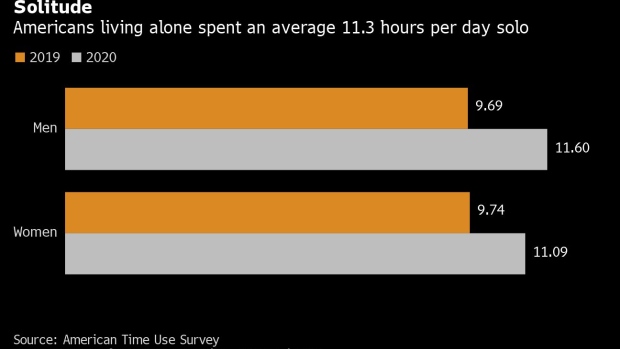Jul 23, 2021
More Lawn Care, Less Hair Care: Survey Shows U.S. Pandemic Habit
, Bloomberg News

(Bloomberg) -- In the pandemic year of 2020, Americans spent a lot more of their days taking care of their kids or in front of screens and devoted less time to self-care, according to an extensive new government survey.
The latest edition of the annual Time Use Survey by Bureau of Labor Statistics, published on Thursday, presents what may be the broadest examination so far of what a typical day looked like for Americans living through a year of upheaval. Some of the shifts from the previous year are likely to persist into the future, as Covid-19 has spawned new economic trends -- and others may soon revert to the status quo ante.
For those who kept their jobs, work still dominated waking hours: They spent an average 7.6 hours per day dedicated to it, unchanged from 2019. But on a typical day last year, only 39% of Americans were working -- down from 43% the previous year, after a wave of pandemic layoffs.
Following are some other key findings from the survey.
Childcare Duty
Secondary childcare, or taking care of children in addition to other activities such as work, took up an average of more than six hours a day last year among respondents with kids, up a hour from 2019.
Women spent more time caring for children than men, at about 7 hours. As classrooms closed and a lot of learning moved to Zoom, causing the average time spent helping kids with educational activities to more than double, that burden fell disproportionately on women.
Overall, the share of people who spent any time providing childcare actually decreased -- sharply among men, and marginally among women. The BLS suggested that’s likely because, with schools and sports clubs shut down, parents spent less time picking up or dropping off their kids, an activity counted under childcare in the survey.
Work From Home
There’s a clear link between childcare duties and working from home, and that’s likely one reason why there was a bigger increase in the share of women who ended up doing their jobs remotely. Almost half of employed women worked at home -- up 23 percentage points from 2019 -- while among male counterparts, the share rose 16 percentage points to 36%.
How big a reverse of that increase there’ll be in 2021 and after remains to be seen. Many white-collar employers are grappling with the new normal for work, as employees seek flexibility and hybrid schedules. And a spike in delta-variant cases in the U.S. could result in many people continuing to spend more time working from home.
Leisure Time
Despite the difficulties posed by Covid-19, Americans on average enjoyed more leisure time -- which was up by 32 minutes a day to more than 5 hours, according to the BLS. Those without kids spent almost two extra hours a day on leisure activities, compared with parents.
A big chunk of the extra downtime was spent unwinding in front of the television, scrolling on phones or -- especially among teenagers -- playing video games. But Americans exercised more, too -- with three notable exceptions: those on the lowest incomes, the cohort in their early 20s, and unmarried men. All those groups spent less time on physical-health activities during the pandemic.
Sprucing Up
As Americans spent more time at home, they put more effort into cleaning and gardening. Time spent on household activities, including food preparation, increased to more than two hours per day.
While both men and women increased the amount of time they spend on these activities, women disproportionately spent more time cleaning, making meals and broadly managing the household.
Living Alone
Lockdowns left Americans spending much more time in their own company, a trend that’s thought to be a key reason why there was a dramatic increase in problems like depression and drug overdoses.
People 15 years and older spent an hour more alone per day on average, compared with 2019 -- bringing the total to about seven hours. Older Americans spent the most time on their own: The daily average was about 7 1/2 hours for those aged 45 and over, rising to almost 9 hours for the oldest age group.
Black Americans and those who earn the most money were among the groups to spend the most time alone. There was also a distinct gender divide, with women less solitary than men.
©2021 Bloomberg L.P.